|
| |
Back to private
aircraft
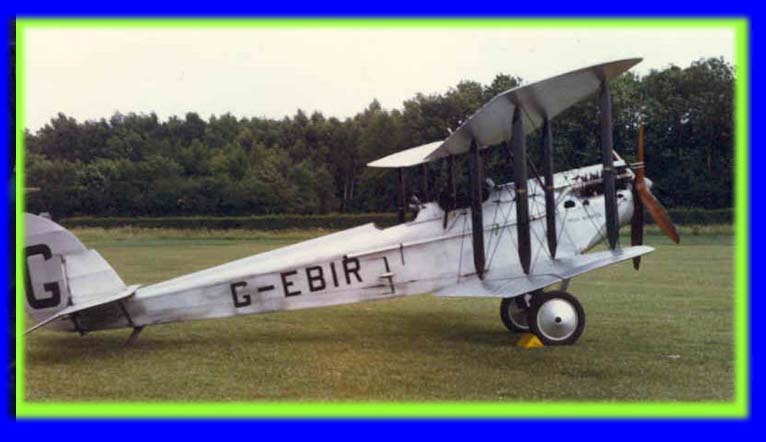 |
The De Havilland DH51 is a three seat touring
aircraft whose appearance clearly presages the famous Moth series.
It is however a much earlier machine (dating from about 1923) and
much bigger (26 feet 6 inches long, 37 feet wing span) and heavier
(gross weight 2,240lb). It is powered by a 120hp Airdisco engine,
which gives it a 90mph cruising speed. Only three were built, of
which I think this is the only survivor, having flown for many years
in Kenya. This picture was taken at the
Shuttleworth Collection at Old Warden in Bedfordshire, where it is
preserved in flying condition. |
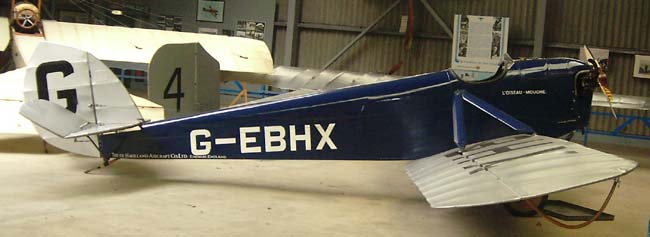 |
The De Havilland DH53 Humming Bird is a
minuscule single seater, built for the 1923 light aeroplane trials
at Lympne. It is powered, just, by an ABC Scorpion engine, though
there were various options including a tiny 26hp 700cc Blackburn
Tomtit! (How it ever flew on that power is a complete mystery). It
is a true ultralight, with maximum weight of only 565lb. But the
dimensions, true to its era, are quite generous, being 19 feet 8
inches long and having a wing span of 30 feet 1 inch. It cruised at
a sedate 60 mph and had the amazing range of 150 miles. Fuel
capacity was measured in pints rather than gallons! Fifteen were
built.
This one is preserved at the Shuttleworth Trust,
Old Warden, where it was photographed by Ivy in April 2005. |
|
|
The De Havilland DH60G Moth was the design
which did more than any other to create a proper light aircraft
industry in Britain. The Lympne trials were great fun but did not
produce any really practical machines. A specification was drawn up
with help from pioneer Alan Cobham, which included things which are
now obvious: for example, must be a two seater, must have luggage
space, must be simple to operate and maintain .... The task of
meeting this specification was fulfilled admirably by this
delightful and sprightly machine. It first flew in February 1925,
and was an instant success. All told, 2,073 were built, an
unprecedented number for a civil machine. There were several
versions, differing mainly in engine. The initial Moths had ADC
Cirrus engines, ranging from 60 to 90hp. 113 of these were built,
plus a further 338 known as the `DH60X' because of their X-shaped
undercarriage bracing struts. The DH60G Gipsy Moth had the DH Gipsy
engine, developed specially for the type and first installed in
1927, and rated from 85 to 125hp; 692 of these were built, plus a
further 753 as the DH60M with a metal rather than wood frame to the
fuselage. The Moth Major is powered by the same engine but mounted
`upside down' (we would today think of it as the right way up!)
which gave greater propeller clearance and made it look a bit like a
straight-winged Tiger Moth (no coincidence!); 113 of these were
made. It is 23 feet 8 inches long, with a wing span of 30 feet;
typical cruising speed is 85mph. Range varies from 290 to 430 miles,
and gross weight from 1,240 to 1,750lb, depending on version.
Many survive, most lovingly cared for and
maintained. These two pictures both show DH60Ms, the top one at
Popham in May 1987 and the lower at Turweston in July 2005. |
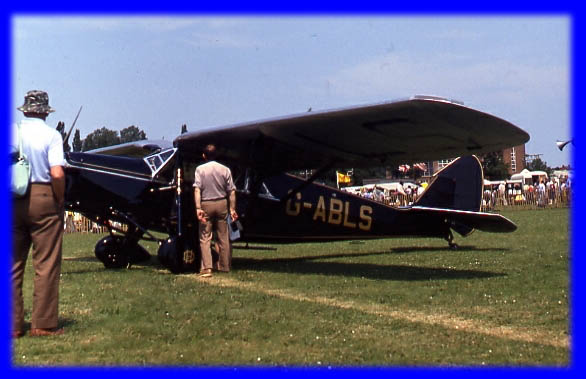 |
The De Havilland DH80A Puss Moth had an
enclosed cabin for greater comfort, and a single high wing for
better downward visibility. It first flew in September 1929. It also
took advantage of the `inverted' Gipsy engine to improve forward
visibility and reduce undercarriage height, making it easier to get
into. It was very popular, with 285 ultimately being built. It is a
two seater, with gross weight of 2,050lb, 25 feet long, with a wing
span of 36 feet 9 inches. Its cleaner lines increased the cruising
speed to 105mph. Range was 300 miles. An interesting feature is that
the wings fold for easier storage. Only
a few survive, of which this is one of the nicest; it was at
Cranfield in July 1983. |
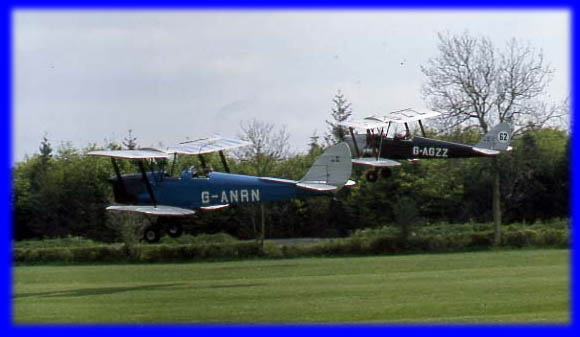 |
The De Havilland DH82A Tiger Moth is probably
the best known of all De Havilland aircraft. It was developed from
the DH60T Moth Trainer, the biggest difference being to move the
centre wing struts forward to improve ease of entry and exit; to
preserve the centre of lift, the wings therefore had to be slightly
swept back. It first flew as such in September 1931. Little
could the designers know that this was the first of over 8,850 to be
built! It was promptly put into production as the standard RAF
trainer, and it continued as such throughout the second world war.
Its Gipsy Major engine (130 to 145hp) gave it a cruising speed of
85mph, range of 300 miles and gross weight of 1,825lb. It is 23 feet
11 inches long, with a wing span of 29 feet 4 inches. And it is an
utter delight to fly ... as long as you remember the rudder (which
pilots of modern Pipers and Cessnas are understandably apt to
forget). This picture of two Tigers
taking off in formation was taken at Popham in May 1987. |
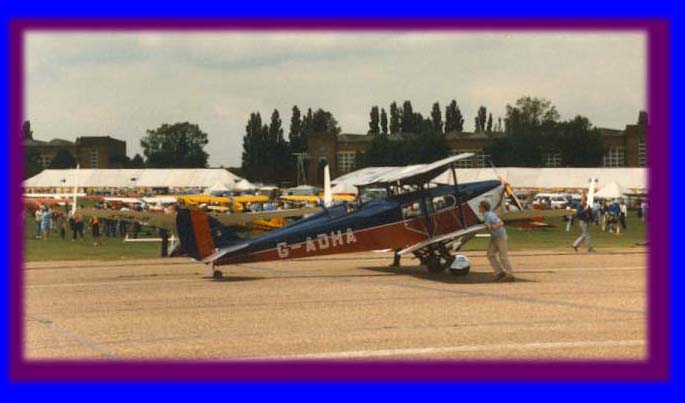 |
The De Havilland DH83 Fox Moth has what now
appears a very unusual configuration, with an enclosed cabin for
four passengers, and the pilot sitting in an open cockpit above and
behind. This had, however, been quite normal before for larger
airliners. The Fox Moth was really intended for short pleasure
flights. It first flew in March 1932, and revealed surprisingly good
performance given its 120hp DH Gipsy engine. Its cost was kept down
by using a lot of Tiger Moth components. Not surprisingly, its
dimensions are fairly similar: it is only 25 feet 9 inches long,
with a wing span of 30 feet 10 inches. Gross weight is 2,070lb (with
empty weight of 1,100lb and five people, this doesn't leave much
room for fuel! Still, when lightly loaded, it does have a 360 mile
range. It was popular for its job; 98 were built.
This is one of the few survivors, seen in a very
poor photograph taken at Cranfield. |
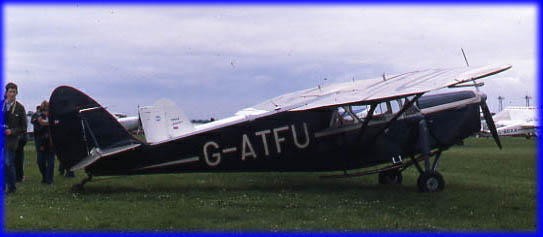 |
The De Havilland DH85 Leopard Moth first flew
in May 1933 as a more refined successor to the Puss Moth. It is
easily told from the earlier type by the mounting of the
undercarriage struts (for easier access) and from below by the
tapered wing. Internally, the main difference is that it is a three
seater. Its 130hp Gipsy Major engine (starting to sound familiar?)
gave it a cruising speed of 120mph and range of over 700 miles, with
gross weight of 2,225lb. It is very slightly shorter (24 feet 6
inches) and wider (37 feet 6 inches) than its predecessor. 123 were
built. This one was at Leicester in July
1980. |
|
|
I will now be vilified by all Moth purists by
asserting that the De Havilland DH87B Hornet Moth is the prettiest
of all the Moth range. It originated as a replacement for the Gipsy
Moth, and incorporated a large number of refinements. It is a side
by side two seater with an enclosed cabin, which first flew in May
1934. The `A' version had tapered wings, but these gave it rather
unpleasant handling at the stall, so the square-tipped `B' version
was produced to cure the problem. Obviously the refinements made it
cost more, and this is probably why only 165 were built. Its
familiar 130 or 145hp DH Gipsy Major engine gives it a cruising
speed of 110mph and range of over 600 miles, while gross weight is
2,000lb. It is 24 feet 11 inches long, with wing span of 31 feet 11
inches.
The top picture was taken at the Moth Club
rally at Woburn Abbey in August 1987. `Ariadne' (G-ADNE), in the
lower picture, was at Kemble in July 2005. |
|
|
The De Havilland DH88 Comet Racer took sleek
aircraft beauty to a new level. Actually it was designed in rather a
hurry. The governor of the state of Victoria in Australia sponsored
an air race from England to Melbourne, to be held in October 1934 to
celebrate the hundredth anniversary of the foundation of the State
of Victoria. De Havilland realised that no British aircraft of the
time had the necessary performance to compete, so in February 1934
they began to design a machine from scratch, specially for the
purpose. It first flew in September 1934, only six weeks before the
race. Obviously in that time the designers did not have time to get
all the details perfect, so the handling was not as good as it could
have been. But it did the job. Its two 230hp DH Gipsy Six engines
tore it through the sky at up to 235mph, but were economical enough
(with the help of very big fuel tanks) to give it the then enormous
range of 2,925 miles. Other novel refinements, introduced solely to
try and win the race, were variable pitch propellers and a
retractable undercarriage. Split flaps were incorporated to make it
possible to land! Three were entered for the race and this one,
named `Grosvenor House' because it was sponsored by the Duke of
Westminster, won - taking just under 71 hours to go essentially half
way round the world. The crew were C.W. A. Scott and Tom Campbell
Black. Although only five were built,
this aircraft deserves its place in the all time hall of aviation
fame. This is the only survivor. The top picture shows it flying at
Old Warden, where it is preserved, in 1991. The lower picture was
taken at Farnborough in 1986. |
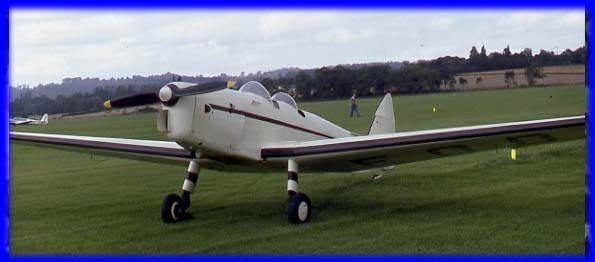 |
The De Havilland DH94 Moth Minor was the last
of the Moth series and the only low wing monoplane Moth (barring the
DH81, which never made it into production). It is a two seat open
cockpit aircraft. It first flew in June 1937. Power is a 90hp DH
Gipsy Minor engine, which enables it to cruise at 100mph for a range
of 300 miles. It is quite light, at 1,550lb gross weight; is 24 feet
5 inches long and 36 feet 7 inches wing span. A total of 118 were
built, several of which were completed as Moth Minor Coupes with an
enclosed cabin.
This one was at Redhill in September 1985. |





|